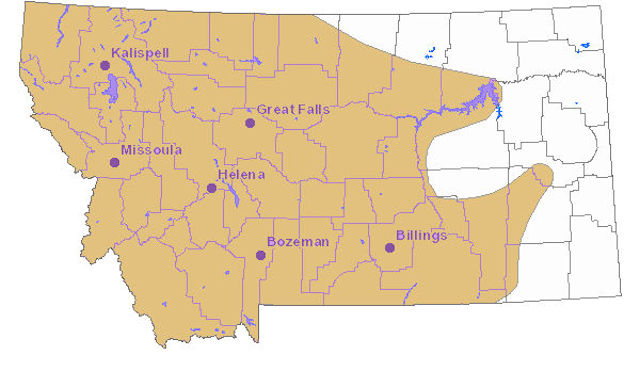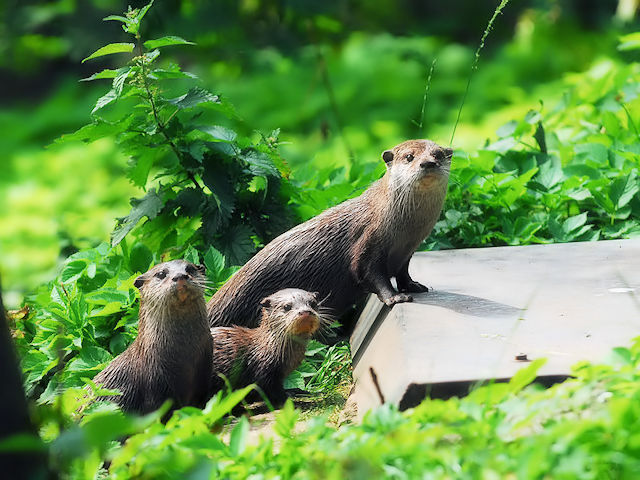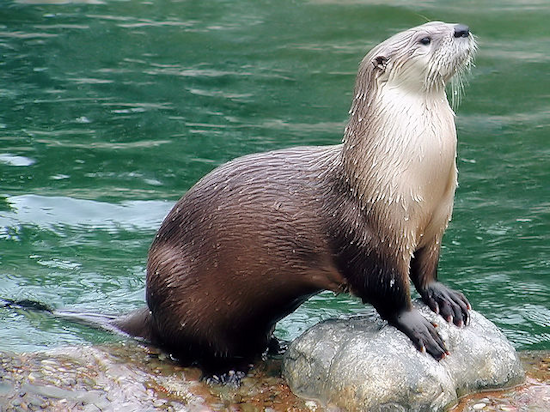Total length: 35 to 54 inches. Weight: 11 to 33 pounds.
Habitat: Inhabits streams, rivers, and lake borders. Riparian vegetation is a key component of otter habitat. Otters often use bank dens first created by beavers. Availability of food, water, and shelter determine the duration and intensity of habitat use.
Food Habits: The otter dies is primarily fish, but it will consume a variety of aquatic prey.
Life History: Active both day and night. One of the most aquatic members of the weasel family. Sociable animal that dens in banks with entrance below water. Breeds during spring; 9.5 to 10 month gestation; delayed implantation; litter size of 2 to 3 is most common.
Similar Species: Beaver - has a flat, scaly tail. Mink - much smaller, feet not webbed.
River otter are highly skilled swimmers. Rough fish make up a substantial portion of an otter's diet, although game fish of medium size are occasionally caught and eaten. Great travelers, otter circuits may cover 60 or more miles, and take weeks to complete. This species enjoys play, and otters commonly play either alone or with others of their kind. Powerful and streamlined furbearers, otter are recognized as one of the more intelligent species.
 Description
Description
Otter have long, slender bodies with relatively
short legs. The neck is long and muscular, as is
the tapered tail. Otter fur is considered as a
short haired fur. Guard hair lengths are about
one inch with under fur lengths of about 3/4
inch. Coloration is brown, with chocolate
colors common in southern states, and darker
colors common in northern states. Otter from all
areas are lighter in color on cheeks, throats
and bellies.
Males are larger than females. Adult males may measure 48 inches in length, and weigh up to 25 pounds. Adult females are usually 4 to 6 inches shorter, and seldom weigh more than 19 pounds.
There are 5 toes on each foot. A web of skin connects the toes on each foot. Claws are strong and nonretractable. Otter have 36 teeth, including 4 long and sharp canine teeth. Valves are present in an otter's nose and ears which close automatically as the otter submerges.
A pair of anal musk glands are present on both males and females. This musk can be released when the otter is frightened, but it is not as offensive as the musk of other members of the mustelid, or weasel, family.
 Reproduction
Reproduction
Breeding occurs over most of the otter range
during March and April, only a few days after
the litter is born. Males leave after breeding
to find other females, but may return 6 to 8
weeks later to join the family.
Delayed implantation occurs, and this varies a great deal. Implantation of the fertilized eggs may take 7 to 10 months before the free-floating eggs attach themselves to the uterus walls to complete the 60 to 65 day gestation. Litter sizes average 2 or 3, with 4 being uncommon. Most otter do not mate until they are two years old.
Abandoned beaver dens are often selected by the female otter for the natal dens. At times, an otter will use a dry land den near the water to raise the litter. All young must be taught to swim.
Habits
Except for the raising of the litter, otter seem
to be constantly on the move from place to
place. They do not seem to defend their
territories from other otter, and overlapping of
regular territories do occur often.
The availability of food, as well as the season, determines how far the individual otter ranges. During summer months when food is easily available, otter may stay within a 20 square mile area. during winter conditions, the same otter may circulate over 60 or more square miles. Circuit times vary as well, and an otter may complete a summertime circuit in a week as compared to wintertime travels taking 3 or 4 weeks.
Otter commonly travel by swimming and loping along shorelines, but they do not hesitate to take off overland to reach a distant steam or pond. These overland trails may be very distinct when otter populations are high.
Otter certainly enjoy sliding on mud or snow. Under favorable conditions, they might bound 3 or 4 times and then slide for yards before continuing to bound and slide some more. Mud slides down steep banks into the water are commonly used in many northern areas as the otter or family of otter take turns climbing the bank to slide down the slide into the water head first.
Otter have a high metabolic rate, and food passes through the entire digestive system in about an hour. Small fishes are eaten whole. Often an otter will eat a fish while floating in the water on its back, holding the fish much like a person eating corn on the cob. After eating, otter commonly vomit up an abundance of fish scales and bones. This prevents a large number of valueless scales from passing through the entire digestive system.
The elongated body, webbed feet and powerful tapered tail allow the otter to be very quick in the water, and they can swim at least 1/2 mile while submerged. When an otter chooses to swim quickly, it undulates its entire body up and down in a ship-like fashion with their front legs held tightly to the body.
Commonly eaten foods include many types of minnows, sunfish, suckers, perch and scullions in western habitats. Also eaten are crayfish (claws not eaten), water snakes, frogs, and aquatic insects. Muskrats are eaten when available, as are mice.
Otter are not known to store food. Although an otter does not kill more food than it will eat, the high rate of metabolism keeps the furbearer hungry much of the time.
Young otter will often stay with their mother through their first winter season. Oftentimes, the young will follow the mother in a single file fashion, both on land and in the water.
General
Although otter can and do eat trout, they
usually help a tout stream by helping to contain
populations of rough fish. When fish are so
abundant as to become stunted, predation
certainly allows more food for the remaining
fish. Although otter sometimes kill muskrats and
ducks, the numbers are so small as to be
insignificant. Otter can devastate fish farms.
This is most apt to happen during the spring
when a family of otter may be denned for 2 or 3
months.
Adult otters are rarely killed by other predators. Lynx and wolves can kill them, and juvenile otter may also be vulnerable to predation by bobcats and coyotes.
Otter are relatively free of parasites due to infrequent uses of dens, constant traveling habits and little contact with other otter that are not family members. However, they are vulnerable to poisons which often show up in fish. Fish killed by acid rain may poison otter, and lethal amounts of DDT, PCB's, and mercury have been found in otter.
A significant habitat loss of otter has occurred over much of their historic range. Farming practices in many area allow muddy and silty water with each rainfall, which discourages fish production as well as interfering with an otter's ability to locate food by sight.
Otter are considered to be old at 15 years.




